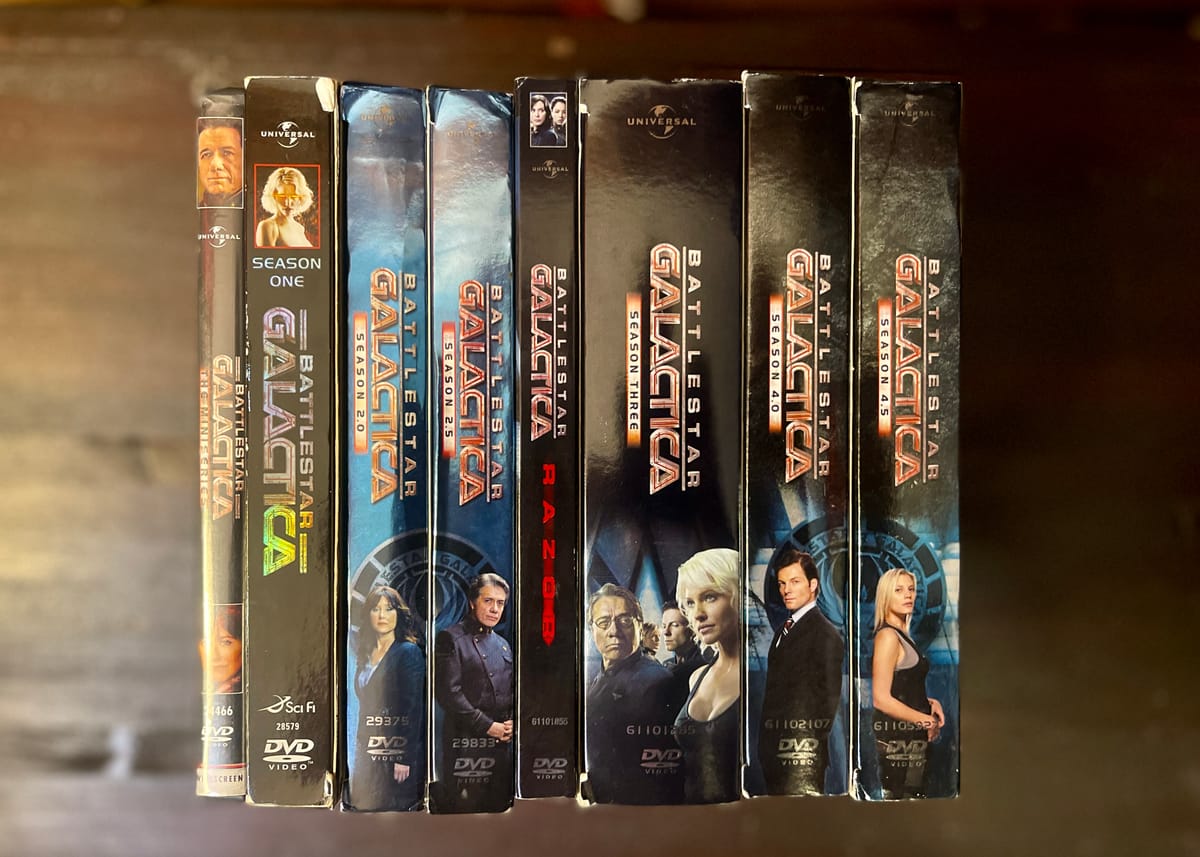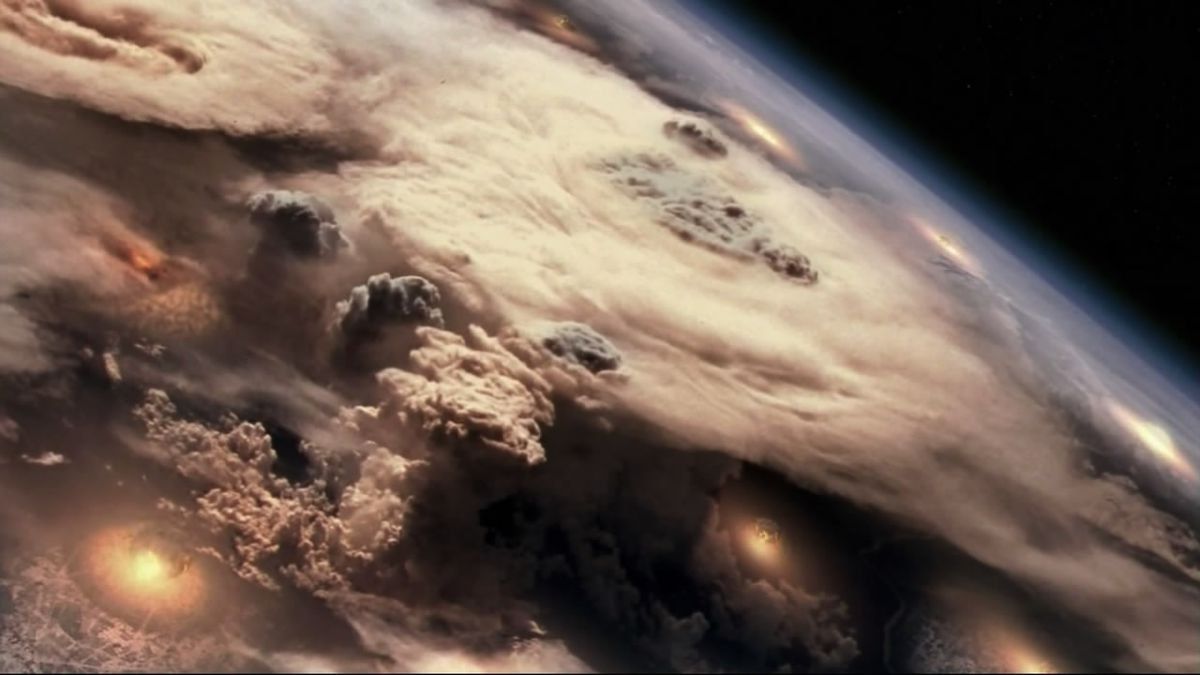So say we all
Looking back on SCIFI's Battlestar Galactica remake elevated science fiction on television, 20 years ago

20 years ago tonight, the SCIFI Channel launched an ambitious new project: Battlestar Galactica, a miniseries that reimagined the premise of the original 1978 TV series for a modern-day audience. Set in a distant galaxy, it followed humanity in the aftermath of a devastating attack from a civilization of robots known as the Cylons as they try to find safety in a mythical planet: Earth.
The miniseries was an enormous hit for the network: it brought a measure of grim realism to a television genre not often known for deeper, hard-hitting stories (although there certainly are exceptions) or deeply flawed characters facing overwhelming, hopeless odds for survival. In many ways, Battlestar Galactica was a moment where science fiction grew up and demonstrated that it was a genre that could tackle the mature, relevant, and thought-provoking stories in a serious way.
The success of SCIFI miniseries and four-season show and various spinoffs was far from a sure thing.
Following the monumental success of Star Wars in 1977, television executive Glen Larson saw an opportunity for ABC: a space opera series like Star Wars, but scaled down to television. Science fiction had its ups and downs on network TV: Star Trek only lasted for three seasons at NBC in the late 1960s, while CBS had launched an adaptation of Planet of the Apes in 1974. "Star Wars gave [ABC] the license to say yes," David Larson recounted in Mark A. Altman and Edward Gross's So Way We All: The Complete, Uncensored, Unauthorized Oral History of Battlestar Galactica. "It was a proven model now. They hadn't done anything like that on TV."
The series followed the crew of a warship after humanity was attacked by the Cylons – hulking, chrome-armored robot-looking aliens bent on wiping humanity out and pursuing them as they looked for a new home. The series lasted for a single season in 1978 and 1979, with new adventures each week as the fleet found new planets and adventures. In 1980, ABC launched a sequel series called Galactica 1980, following the adventures of some of the characters after they discover Earth, which ran for only 10 episodes.
There had been efforts over the years for some sort of followup to the franchise. Series star Richard Hatch attempted a continuation called Battlestar Galactica: The Second Coming in 1999 that would have united the original cast, but ultimately, it never got off the ground beyond a 30-minute proof-of-concept pilot for which Hatch screened a trailer at various conventions.
According to So Say We All, the roots of the reimagined Battlestar Galactica came from Ronald D. Moore's tenure on Star Trek Voyager and Star Trek: Deep Space Nine, where he felt constrained. "Ron came onboard as a writer and he came aboard wanting the show to do all sorts of things," Brannon Braga, Voyager's executive director recounted. "He wanted the show to have continuity. When the ship got fucked up, he wanted it to stay fucked up. For characters to have lasting consequences. He wanted to eradicate the so-called reset button, and that's not something the studio was interested in, because this thing was a big seller in syndication."
Following his work on Star Trek, Moore worked on a series called Roswell and an adaptation of Anne McCaffrey's Dragonriders of Pern for Warner Bros., but ultimately backed out after interference from the studio. After he walked away from the show, he was approached by David Eick, a producer at Universal, who told him that the studio had been working on a new version of Galactica, but hadn't quite figured it out yet, and if he'd like to take a shot.
Their meeting took place shortly after the terror attacks in New York and Washington DC on September 11th, and Eick recounted that when he'd sat down with Moore, he had been reluctant. "We started talking and to my surprise, he recalls that the pilot of the original involved this holocaust, and at that moment, we were bleeding raw from 9/11. We're thinking, what if we took it really seriously?"
"I was like 'okay, if I remake this now, in today's world and about this attack, and what it does to these people, and the questions that would come up, and the survivors – what they would do. And the military verse the state authority. And freedom verses security. My God, this is an enormous opportunity and I could put in effect these ideas about shooting a new kind of sci-fi story and now having a big viewscreen, and not doing the captains' chair. Being more documentary-style in production and doing this naturalistic approach.' I just got excited about it and I said 'Okay, David, I'm in."
From there, he went about reimaging what this story and world would look like. The same basic plot points from the original series remained: humanity was fleeing a holocaust and relentlessly pursued. Some of the characters remained: Captain Apollo, Adama, Starbuck, Baltar, but with some changes. Gone was the planet-of-the-week adventure serial and light-hearted exploits of the crew.
The resulting story introduces us to the world on the eve of the attack: humanity had once fought against the Cylons – now robots that had rebelled against humanity, and after a long armistice, the Battlestar Galactica was set to be turned into a museum and its captain, William Adama, was set to retire after a long career in the Colonial Fleet. Everything changes when the Cylons launch a devastating attack – aided by a brilliant, egotistical computer scientist named Gaius Baltar that devastates the colonial worlds with nuclear attacks.

The three-part pilot is a brilliant example of story pacing. We're introduced to an ensemble of flawed characters who find themselves the last remnants of humanity: hot-headed pilots, a cabinet secretary thrust into the chain of command, crew members dealing with affairs and complicated relationships, now the only hope that their fellow survivors had.
It was like nothing that I'd seen on television up to that point. Moore and his team redesigned the science fiction series, grounding every element in the real world. They toured air craft carriers to try and capture the look and feel of how a warship might actually operate, while the characters wore uniforms that were a far cry from the gaudy and colorful ones that you might have seen them wear in decades past. The story took on new relevance as the world contended with the aftermath of the 9/11 attacks and the recent US invasion of Iraq. The series, director Michael Rymer explained to Sci-Fi Magazine, is "a powerful allegory for our times...It posits to our world that there are murders, there are despots, there are terrorists, there are terrible people that want to cause us harm, and it's not necessarily true that if we smile and are nice, they'll stop doing it."
The miniseries captures that viewpoint perfectly: it focuses on the characters reacting to this overwhelming attack and doing everything that they think they can accomplish with what they have. They have to figure out in the moment that they have no hope of surviving if they stand and fight, and accordingly, figure out what their priorities are. Along the way, they have to make incredible sacrifices, leaving crew members behind, making desperate strikes, and making some impossible decisions along the way. By the end of the three hours, they're exhausted and realize that they have only one choice if they want humanity to survive: flee.
Following the release of the miniseries, Moore penned a series bible for where the series could go. "Our show is built on the idea that a science fiction series can employ ground-breaking special effects, dynamic cinematography, realistic situations, believable characters and explore contemporary social and political issues without sacrificing dramatic tension or excitement."
While shows like Star Trek: Deep Space Nine and Babylon 5 were known for their long-running storylines, this wasn't the norm for most shows. Science fiction shows like Star Trek and Stargate SG-1 relied on episodic seasons, where viewers could dip into any given episode and understand the premise. Moore set out to avoid this altogether: using long-term storytelling as a model to explore the bigger problems the characters faced. While there were still episodic elements to most episodes, the longer arcs allowed the shows writers to dig deeper into the characters than they might have been able to do otherwise.
It's hard to understate just how much of a revelation this was for viewers back in 2003 and in the years that followed. This was a series that was exploring some difficult topics – everything from how to treat prisoners of war to the balance of power between the military and civilians, tests of loyalty, religion and faith, and how none of the decisions leaders might make have a clear-cut or safe answer. These were questions that were circulating within the US as we watched the beginnings of the wars in the Middle East and the extreme polarization of the nation's politics. The series would end up earning some notable awards like the Peabody, while the United Nations invited the writers and actors to a panel discussion on human rights and warfare.
In his book The Platinum Age of Television: From I Love Lucy to The Walking Dead, How TV Became Terrific, critic David Bianculli noted that there has been a convergence in technological innovation and creativity that have lead to what he calls "The Platinum Age" for the industry that has led to stories that are more complicated and sophisticated than their predecessors. Battlestar – the miniseries and the series – arrived at a critical point in the history of television. Streaming and even binging wasn't a thing, but DVD sales were hitting their stride (the peak would come in 2005), allowing viewers to buy and consume entire seasons of TV shows over the course of a couple of days. DVD sales certainly helped with Battlestar's popularity (and with other shows like Joss Whedon's Firefly), and it allowed entirely new audiences to pick up the series and rewatch it at their leisure.
Moore's approach to the form that Battlestar Galactica has had a considerable and lasting impact on the modern TV world; it and shows like LOST helped acclimate a larger audience toward serialized storytelling that focused extensively on character growth and consequences that have become commonplace as streaming took over Hollywood. It's hard to imagine shows like Syfy's Stargate: Universe or The Expanse (adapted from James S.A. Corey's novels), Star Trek: Discovery, The Man in the High Castle, Westworld, Game of Thrones, or Star Wars: Andor without Moore's grittier view.
Audiences have clamored for dense, story/character-driven narratives that explore the complexities of life: Battlestar helped pave the way for those stories that now dominate the cultural zeitgeist and make us think about the world in new ways. So say we all.